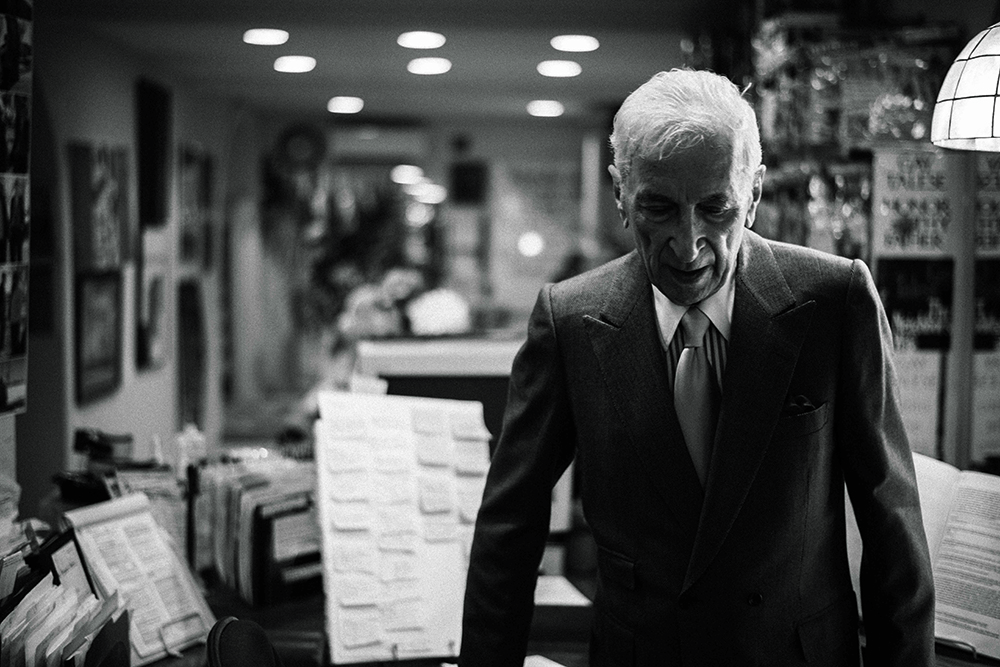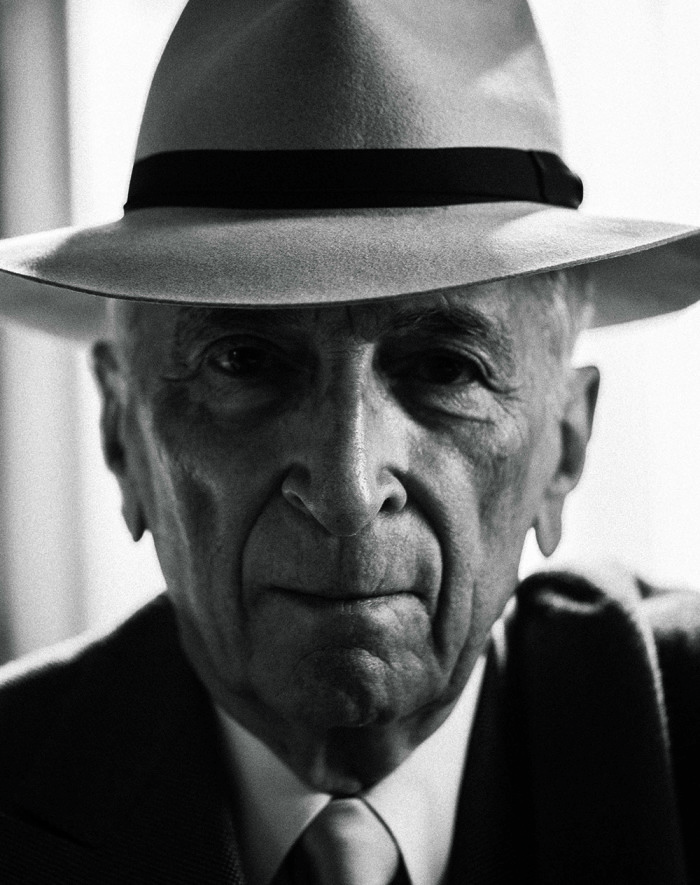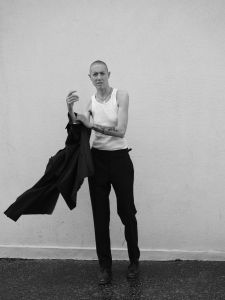PORT visits the Manhattan apartment of Gay Talese, the writer whose investigative curiosity and distinctive prose elevated journalism to the status of an art form

Gay Talese stepped out from the basement office of his Park Avenue townhouse and a heavy-set postal worker making deliveries on the street brightened when she saw him.
“You look very nice today, Mr. Talese,” she said, complimenting his elegant grey suit and hat.
He smiled and thanked her, accepting a packet of mail, and continued to walk up the spiralling black staircase that leads to his front door, on which large a brass plaque reads, “Talese.” She watched until he entered, and then continued on her delivery route.
People enjoy appreciating Talese, as though he were some rare exotic bird. They appreciate his immaculate suits and signature leather and suede trimmed shoes, his preference to not own a cell phone, his expertise in preparing a gin martini, and that at 82, he is in sharp form, able to walk up and down the carpeted steps of his elegant five-story home on Manhattan’s Upper East Side with relative ease. For those evaluating him as a writer, as an icon of American nonfiction, this appreciation seems to have only grown in recent years, in the form of awards, interviews, book reissues and young writers seeking his wisdom and time.
Journalists are often cursed, through the ephemeral nature of their trade, to be forgotten soon after their stories are told, but for the past 60 years Talese has been a unique American chronicler. His signature style distinguished him. As any journalism student in college can tell you, Talese implemented the techniques of fiction writing into the domain of nonfiction, first as a reporter at The New York Times in the 1950s, then as a scribe for Esquire in the 60s and then as a writer of ambitious bestsellers that undertook topics people considered ‘unreportable’. He wrote real stories about real people, but in ways that evoked the engrossing narratives of fiction.
“I wanted to write stories like fiction writers were,” he said. “But I wanted to write without fabricating, without imagining, without falsifying.” He’s cited as a pioneer of ‘New Journalism’, along with writers like Joan Didion, Norman Mailer and Truman Capote, but he’s always resisted the categorisation.
He is a master observer, often preferring the marginal tale over the big one; the piece not about the boxer, but about the man who made the boxer’s mouthpiece; the piece not about the politician who died, but about the man who penned his obituary. He favours losers instead of winners, seeing powerful tales in their in downfalls and redemption. He picks weighty themes, especially in his books, illustrating them with rich but factually verifiable scenes of human drama, spending months with his subjects, entering their heads. “When I write about someone, I make them my literary property,” he said. “Most journalism is a one night stand. A quick fuck and then you’re out. With me there’s no divorce. Stories are never over.”
Talese’s bestsellers could take a decade each to complete. Thy Neighbor’s Wife covered the landscape of the sexual revolution, generating controversy, as he became a participant in the lustful movement, in the name of his research, despite being a married man. Honor Thy Father cast a human light on the underworld of the mafia through the window of the Bonanno crime family, of whom it took Talese years to gain trust. In The Kingdom and the Power he put faces on the individuals behind The New York Times, illustrating the day-to-day dramas of the august news organisation.

But it was particularly through Talese’s work as writer for Esquire in the 1960s that he solidified his reputation as a unique storyteller. His articles have become seminal works, especially his 1966 piece about Frank Sinatra, considered legendary, in part, because Sinatra declined to be interviewed. And yet, Talese wrote about him anyway, speaking to the individuals in his sphere – his valet, his tailor, the woman who carried his hairpieces – and composing a portrait that some felt explained the man better than anything else. Esquire has singled it out as the greatest story they ever printed, and journalism schools around the country require it as reading. “I’ll never get away from that story,” he said. “I still don’t think it’s my best.”
Even as a young reporter on The New York Times, Talese stood out, painting more colour with facts than other reporters could. His poetic articles sometimes raised the eyebrows of his colleagues, who suspected fabrication at work. The creative restraints of newspaper journalism ultimately caused him to leave for Esquire in 1965. “I felt like I had gone as far as I could go,” he said. “I remember leaving, I got in the elevator, the same elevator I came in as a copyboy way back, and I was crying.”
He was born to an Italian family in the small beach town of Ocean City, New Jersey in 1932. His father was a tailor and his mother owned a dress shop. He traces his formation as a reporter to the days of sitting in her shop, listening to customers discuss their private lives: witnessing the art of interviewing in its fundamental form.
He’s now working on his next book, which will turn a lens on his marriage, and how it survived the scandalous research methods he used for Thy Neighbor’s Wife. He’s also working on a project he believes may be his best yet, but he prefers to remain quiet about it. And then he’s busy with the pilgrims – the young writers who seek his knowledge – or the reporters who want to quote him in a story, or those who want to honour him with awards, as the prestigious Norman Mailer Center recently did, or there’s the renowned art book publisher, Taschen, which has plans to bring his Frank Sinatra piece to life.
I’ve known Talese personally for some years, and we recently sat in his living room to discuss his career. The home throbs with literary history. Bookshelves are everywhere, filled with the works of old friends, titans such as David Halberstam, George Plimpton and Tom Wolfe. The novelist William Styron wrote parts of The Confessions of Nat Turner here. Talese’s wife, a prominent editor who works with Ian McEwan, is an influential figure in her own right. Some say his basement, where he spends much of his time, reflects his mind. Almost every article he has written, and observation he has jotted, is archived there in a box or filing cabinet.
A jangle of keys sounded from his front door. A dog walker entered, his wife’s two Australian terriers wagging behind her. “Everything fine, Angela?” he asked.
“Angels as usual, Gay.”
The energetic bodies of fur disappeared up the stairs behind her. Talese reflected on his contributions to journalism.
“I wanted to be a storyteller,” he said. “I wanted to write short stories with real names. I didn’t want to write novels like everyone else. I wanted to be different. I wanted to be a star of nonfiction.”
“If I’ve done anything,” he added, “it’s been to help elevate journalism to an art form. I do believe it can be an art form. And I’m not modest about that, because that’s what I set out to do, and have been doing, without shame, all these years.”
Photography by Max Vadukul
This article was first published in issue 14 of PORT. To buy or subscribe to PORT, click here.




